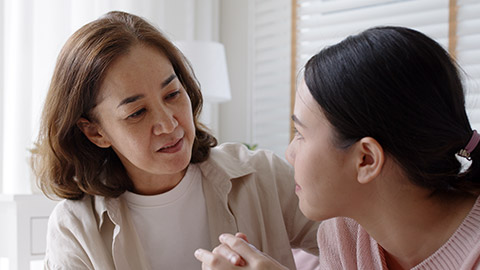What does it mean to be vulnerable?
A vulnerable population is considered to be an individual or group that are at higher risk of health care-related issues.
Those individuals using health and wellbeing services may have health conditions, disabilities, socioeconomic factors, or living environments that make them more susceptible to abuse and that potentially lower their ability to protect themselves from harm.
Individuals that are supported through health and wellbeing services tend to be more reliant on other people for support which, in turn, can make a person more vulnerable to abuse.
What is vulnerability?
The Oxford dictionary defines vulnerability as “the quality or state of being exposed to the possibility of being attacked or harmed, either physically or emotionally”.
A vulnerable person is one who is either oppressed or more susceptible to harm.
From a health perspective, situations of vulnerability may include suspected or actual abuse, neglect and violence, mental distress, suicidality, power imbalances, social isolation, impairment, health status, trauma or a combination of factors unique to a child, person, family or whānau which place them at risk of harm or adverse outcomes.
Individuals who use health and wellbeing services tend to be reliant on other people for support, which can mean they are in a position of vulnerability.
Healthcare providers have policies and procedures on how to respond to situations of suspected vulnerability.
Factors that contribute to vulnerability
Vulnerability factors are situations that can lead to a person being at risk of harm or adverse outcomes.
Personal characteristics of a person at risk of vulnerability
- Age (minor or elderly)
- Stress
- Impairment
- Neglect
- Addiction or addiction relapse
- Isolation (social or physical)
- Poor health
- Lack of sleep
- Power imbalances (over dominance)
- Mental illness
- Natural disaster
- Lack of whānau/family/community support
- Economic disadvantage (poverty)
- Low level of literacy/language proficiency
- Immigrant background
Other characteristics may include:
- Communication difficulties
- Physical dependency – being dependent on others for personal care and activities of daily life
- Low self-esteem and feeling they are not worthy of being treated well
- Not having mental capacity to make decisions about their own safety, including fluctuating mental capacity associated with mental illness and other conditions like addiction
Social or situational factors that can increase the risk vulnerability may include:
- Being dependent on others for care
- Not getting the right amount or the right kind of care needed
- Isolation and social exclusion
- Stigma and discrimination
- Lack of access to information and support
- Economic disadvantage and poverty
- Unsafe living environment
- Natural hazards or disasters
Other impairments - People who have reduced strength, energy or alertness are vulnerable to abuse. These impairments can be caused by a range of things such as medical conditions, drug use, allergies, accidents, or may be unknown.

Abuse
Compared with the general population, vulnerable people experience a significantly higher level of abuse (Mirfin-Veitch et al 2014). To work with vulnerable people, you must have an understanding of what abuse is.
Trigger Warning
Some forms of abuse are obvious, while others can be more subtle and harder to detect. We will look at forms of abuse to help you identify behaviours and signs of abuse in a vulnerable person. Please note that this content may be distressing for some people.
Forms of abuse
To abuse someone is to harm or hurt them in some way or violate their human or civil rights. Abuse can take many forms, including but not limited to:
- physical abuse
- sexual abuse
- emotional or psychological abuse
- financial abuse
- neglect and poor practice
Who abuses?
An abuser is generally someone who has a position of responsibility to provide for the care and wellbeing of the person being abused, such as:
- a partner or spouse
- someone in a position of trust
- a family member – a mother, father, sibling, or other relative
- someone unrelated
- a formal or informal caregiver
Abusers often assert superiority and employ manipulative tactics to control others.

Neglect
Neglect is a form of abuse.
Failing to look after someone for whom you are responsible or failing to give the support or attention that is needed is considered to be neglect.
Neglect can be active or intentional. Neglect can also be passive or unintentional. The people you support can also neglect themselves. This is called self-neglect. Self-neglect can also be active or passive.
Indicators of neglect
It is important to remember that neglect can be by others, or it can be self-inflicted. The following are possible visual indicators:
Neglect by others
- Failing to provide food, water, adequate shelter, or clean clothing
- Abandoning a person by leaving them in any situation without arranging necessary care when there is no intention of returning
- Deliberately not washing a person's bed linen when it has been soiled
- Failing to see or comply with the medical care a person needs
Self-neglect
- Not eating properly because it's too much bother to cook for one person
- Taking no notice of instructions about when or how much medication to take
- Ignoring personal care such as showering or cleaning teeth
Support and reporting abuse or neglect
In your role, it is your duty to ensure that you implement the Code of Rights into the support you provide.
Compliance with the Code of Rights and organisational protocols minimises the vulnerability of individuals accessing health and well-being services.
But how can you support someone if they tell you they are being abused, considering their privacy, dignity, and autonomy?
Watch: Responding to concern about abuse (2:30 Minutes)

Types of vulnerability are directly related to their connection to the potential of harm or abuse.
Four types of vulnerability
Physical vulnerability
Physical vulnerability is when a person has an increased risk of injury or the reliance on physical support to complete daily tasks.
The reliance on physical support from others can increase the risk of abuse or neglect. A person who is in need of physical assistance may mistakenly seek support from someone who is not trustworthy and who may take advantage of them.
Emotional vulnerability
Emotional vulnerability can occur when a person is socially or emotionally isolated, which can lead to loneliness or a feeling of being powerless.
It can also be when a person is reliant on others for their care which can create power imbalances. Emotionally vulnerable people may seek closer relationships or choose inappropriate relationships that can lead to abuse. An abuser may be in a position of authority or control and create an emotionally dependant relationship.
Financial (or economic) vulnerability
Financial (or economic) vulnerability can happen as a result of a person having their working hours decreased or losing their job, or an increase in expenses that cannot be met.
It can also result from a lack of control over personal finances or having to be dependent upon financial supports, such as institutions or family.
Environmental vulnerability
Environmental vulnerability is when a person suffers reduced quality of life caused by external conditions or surroundings.
This can occur after a disaster such as a flood or earthquake. Contributory factors to environmental vulnerability can include family stress, exposure to family violence, neighbourhood deprivation, poor school environment, poor parental health, and low parental education.
In mental health, vulnerability factors are the circumstances and experiences that affect a person’s ability to cope well or regulate emotions. For example, being tired, hungry, experiencing financial difficulties or having a history of Post-Traumatic Stress Disorder could be vulnerability factors.

Being in a vulnerable situation increases the risk of being abused.
What is your responsibility as a support worker if you suspect a service user or their whānau is in a vulnerable situation?
In your role it is your duty to ensure that you follow the Code of Rights with the support you provide.
By following the code of rights and organisational policies and procedures you can reduce the vulnerability levels of the people you support.
Steps to take
If you think abuse might be happening or has the potential to happen, you must report it to your supervisor.
It is your role to:
- listen to the person, trying not to display your own emotions or judgements, such as alarm or disgust
- acknowledge their disclosure in a way that lets them know you are taking them seriously
- inform the person that you are there to support them and that the abuse is not their fault
- record the facts and report the disclosed abuse as your organisation requires
- as much as possible, respect the privacy and confidentiality of the person
- do your best to ensure the safety of the person, if necessary
Learning checkpoint

How can you support someone if they tell you they are being abused?
- Developing a trusting relationship with a person and their family members is a good place to start
- Make sure the person you support understands their rights to live free from abuse and how to identify grounds for complaints
- Remind them that abuse can happen at any age, and it should not be tolerated. It is never acceptable and is a violation of the person’s rights
You can support people by giving them an opportunity to talk about what is happening by asking non-threatening, reassuring, supportive questions, such as:
“Are you getting all the care you need?”
“Who makes decisions in your life, like how and where you should live?”
My 8 Steps Response Kit
Follow these eight steps when you encounter reports of abuse or neglect.
- Reassure and validate the service user concerns.
- Actively listen to the service user concerns.
- Empower the service user.
- Keep it confidential.
- Report the incident to a trusted authority.
- Provide support resources to the service user.
- Document the incident.
- Provide follow-up support for the service user.
It is not your role to:
- investigate the suspected abuse
- question the person about their abuse
- make judgements about the abuse, potential abuser, or the abused
You must at all times respect the rights of the person in terms of privacy, dignity, and autonomy.

Vulnerable service users can pose different level of risks to themselves and to others around them.
According to the Ministry of Health report written by Dr Janice Wilson, the following guidelines need to be followed by healthcare professionals and the multidisciplinary team when identifying service user risks and conducting Clinical Risk Assessment and Management.
What kinds of risk?
Risk assessment is broader than just the risk of violence to others, though this is of most concern to the public and media.
The principal categories of risk are broadly:
- the risk of progression of illness – risk to the health of the individual
- the risk of deliberately induced harm to self, including suicide
- the risk of unintentional harm to self or exploitation
- the risk of intentional or unintentional violence or fear-inducing behaviour towards others
Assessment of risk
Risk assessment is an integral part of every clinical observation or assessment. Risk assessment does not occur on a ‘one off’ basis but is ongoing, with a particular emphasis at ‘critical points’, such as:
- first contact with a service
- change or transfer of care
- change in legal status
- significant change in mental state
- discharge, or move to a less restrictive environment
Risk should be reassessed at regular intervals, and any change in risk (increase or decrease) should be noted.
Limits of risk assessment
It is not possible to identify and eliminate risk entirely.
Even in the best of circumstances, and using the most carefully applied assessment and management methods, adverse events will still occur from time to time.
The objective of good clinical risk management is to minimise the likelihood of an adverse outcome.
Sources of information
Assessment of risk is based on:
- factual information
- informed opinion
Good assessment requires an adequate database. Sources of information should include:
- the individual
- other informants, for example, family, friends, work colleagues
- previous clinical records
- other health sources, for example, GP
- police and court records
Great weight should be given to information and opinion gained from those who know the individual well, whether they are family, friends or staff.
Working together with the multi-disciplinary team, the process of risk management planning can be outlined as follows:
- Identify and document risk factors
- Formulation of risk for the individual
- Weighting of risk(s)
- Develop risk management plan
- Based on formulation
- Compromise ('balance') of risks
- Communicate about the plan (in consultation with the consumer, family/caregivers)
- May be on paper, face to face
- Consider issues of access, privacy, crisis management
- Communication within team, service, other services, families, other agencies, individuals
- Act in accordance with the plan (in consultation with the consumer, family/caregivers)
- Treatment, monitoring, restrictions, environment, existing policies/protocols
- Use of Mental Health (Compulsory and Treatment) Act 1992
- National MH standards
- Consider roles and responsibilities, resource implications
- Evaluate outcomes
- Positive/negative
- Review the plan (in consultation with the consumer, family/caregivers)
- Regular, ongoing, at crisis points
- Ensure full assessment
- Identify gaps, recheck with consumer, family, consider new information
Vulnerability is a complex issue that can manifest in various ways and impact individuals and their families all differently.
Research suggests that when a person experiences vulnerability, it can have significant effects on their family members' emotional, social, and economic well-being (Woollett & Maguire, family psychology).
For instance, a person's vulnerability due to physical or mental illness can cause emotional stress and strain on their family members. Family members may have to provide care and support, and this can be a significant burden, both physically and mentally.
Research has also shown that family members of individuals with mental health problems can experience feelings of stigma and social exclusion, leading to isolation and loneliness (Hoffmann & McNamara, 2010).
A person's vulnerability can also impact their family's economic well-being. For example, if the vulnerable individual is the primary breadwinner, their inability to work due to illness or disability can cause financial strain on the family.
In some cases, families may also have to pay for medical expenses, therapy, and other services to support the vulnerable family member.

Professional boundaries are the limits and expectations of appropriate behaviour between healthcare professionals and their patients.
These boundaries are important for maintaining a safe and effective therapeutic relationship between healthcare professionals and their patients.
Support work involves establishing relationships between workers and service user within personal and intimate settings, often in the client's own home. Building rapport and trust is crucial in creating a calm and supportive environment.
Given the personal nature of these relationships, it is important to educate service user and whānau, and to have open discussions about professional boundaries before entering into any agreements.
Vulnerable settings
Care workers support individuals in vulnerable settings, such as assisting with personal care tasks like showering.
Clients trust the workers to provide appropriate help in these intimate situations.
To ensure best practice, support workers should:
- remain calm, positive, mature, and respectful
- address clients professionally, using appropriate titles or preferred names
- avoid nicknames and endearing terms such as dear or love, as they are unprofessional and cross boundaries
- before starting care, it is recommended to:
- have a discussion with the client or their family to establish best care guidelines
- agree on appropriate areas of the body to touch or support. (e.g. under the arms, upper back, calves vs. lower back, upper legs, etc.)
- set boundaries to ensure touch is helpful and supportive, avoiding confusion or unwelcome gestures (MyCare, 2023)
Relationship boundary
Your role as a support worker is to empower individuals and build a client's support network.
To fulfill your duty of care, it is important to establish rapport and trust with your client. However, always remember that they are the service user, not your friend. It is not recommended to form relationships with the client's family members beyond what is necessary for your care responsibilities.
Avoid becoming overly attached or emotionally entangled in the client's life. Keep your social and family life separate from your work, and refrain from sharing unnecessary personal information with the client.
Further reading
For more information on professional boundaries, read through the following 36 pages of this interactive document to empower you with basic measures you could use with your clients.
The following is a fictional case study to get you thinking about future scenarios.
Case Study
She lives with her parents who are from a non-English speaking background. You support her with basic household chores.
One morning you arrive and find her visibly upset. She tells you that she was approached at work yesterday by her male supervisor who made suggestive sexual comments to her. She doesn’t want to go to work today. She is afraid she will get into trouble for telling you about it and thinks she could even lose her job because no one will believe her story over the story of the supervisor.
She does not want to tell her parents about what has happened.
How would you respond to this situation?
- Apply the My 8 Steps Response Kit plan
- Check the policies, procedures and the Code of Rights
- If you are in any doubt about what you should do in a situation like this, especially if you think a service user is at risk, talk to your supervisor about it immediately
Document your activity response
- Use the following documentation tool to write and export your responses as a document.
- Don't forget to head to the Forums to join the discussion in the 1.7.8 Case Study thread.
